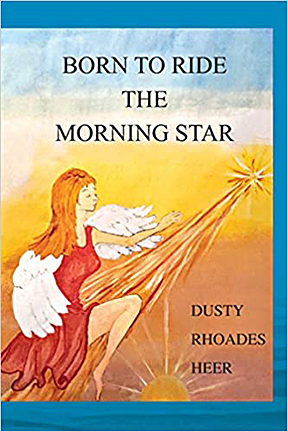Born to Ride the Morning Star by Dusty Rhoades Heer
It’s a particular joy to me to read and review a book by a local writer – if for no other reason than he or she did it. They wrote that book that, I heard somewhere, everyone has in them. Never mind notorious atheist Christopher Hitchens witticism that in them “is, in most cases, where it should stay.”
 So far, of the local writers’ books I’ve been privileged to read, not one has failed to entertain, challenge, and involve me. Every one has owed it to their audience to get their book on paper so that we, the readers, could enjoy them.
So far, of the local writers’ books I’ve been privileged to read, not one has failed to entertain, challenge, and involve me. Every one has owed it to their audience to get their book on paper so that we, the readers, could enjoy them.
This book is no exception. Among the first things you’ll note embarking on this literary adventure is its free form. The narrative moves, with surprising fluidity, from memories, to poems, to a year-by-year account of life from meeting “Sylvia” to the book’s publication (in 2020), to “Dusty’s Lunchtime Stories,” to laundry lists of bands, concerts and sporting events. While it follows a somewhat chronological storyline, the author will frequently dip into a series of memories, based on an activity or a person, that trace an interest or series of events that, as memories often do, occupy his thoughts – and our attention – for a time before resuming the narrative.
And the odd thing is, as a reader you simply (after a little logical rebellion), go right along with the writer’s style, dropping a thread there and picking up another one there – almost as if examining an intricate piece of embroidery an inch away from its surface, with an occasional pull back to remind you of the overall piece.
The book is one part far-reaching travelogue, in that much of each year he recounts is occupied with the places that year took him to, and he subdivides each year into the months which were framed by a trip or series of trips. The trips are anywhere from a quick hop up to the St. Lawrence River to a more exotic port of call in Hawaii or Florida.
In another way, the book is the story of a generation – those children born at the close of World War II, who lived in a world of freedom, exploration, innocence, and seismic changes. Sometimes I’d stop reading and look up from the pages and wonder, “how did one person manage to do so much in only one lifetime?” and then, “and how did he remember it all? Was it in some kind of journal?” Many of the references, too, are to the music and movies that shaped the Baby Boom generation, and reveal the writer’s attention to the sounds and stories of his generation.
Surprisingly, the book is at once sweeping, painted in broad impressionistic strokes, and detailed, as if done with the use of carefully precise pen and ink. A year of work will go by in a sentence, at the same time every road trip, its mileage, weather, stops, meals, chance encounters and unexpected turns are recorded in loving detail, from the sky painted pink at a sunset to what Heer no doubt discovered as he recollected a walk around Green Lake (that it is meromictic) and perhaps did a little research out of what I’d guess is an abundance of natural curiosity. As Heer recites a few stops on a trip, and mentions a sight he’s seen or place he had dinner, I’d find myself thinking, Oh, I forgot! I’ve been there, too! Visits to Montreal, or Cape Cod; to the Adirondacks or Delaware; would get me thinking about the magical trips I’d taken – opening a whole internal dialogue on what my own visit was like, the things I saw, the adventures I had.
The book is also, of course, a love story. And while this story might be ultimately called sad, even tragic, it remains hopeful and a thing of beauty.
The object of Heer’s abiding love is Sylvia – the aptly named woman of an almost ethereal beauty and gentle nature who captures the writer’s heart almost at first glance. And from that moment forward, it is “Syl and I…” “Syl said…” “Syl wanted…” “Syl and I, Syl and I, Syl and I…” 
Dusty and Syl have a once in a million loves, and while I’m tempted to write “that drips off the pages,” it does no such thing. It both is, and is not, the dreamy kind of union or skywritten declaration of a relationship most love stories are about. Yes, there is that magical quality to it. And at the same time, it is fun, bright, interesting, and practical. Two young people meet, fall in love, and spend their time exploring the world together, because, after all, it’s there and they want to see it!
And while the story also includes loss and sorrow, it is bouyed up by the kind of character and bravery you’d love to find in your friends – and, in fact, it is that very quality, the sense of having a conversation with a friend in which you’re catching up on the things he’s done, the places he’s visited, the unusual and amusing and even amazing things he’s seen and done, that make this book a fascinating journey.
And I’ll end with this thought that kept recurring as I breathlessly followed Heer from one adventure to the next: where the heck does that kind of energy come from? 










